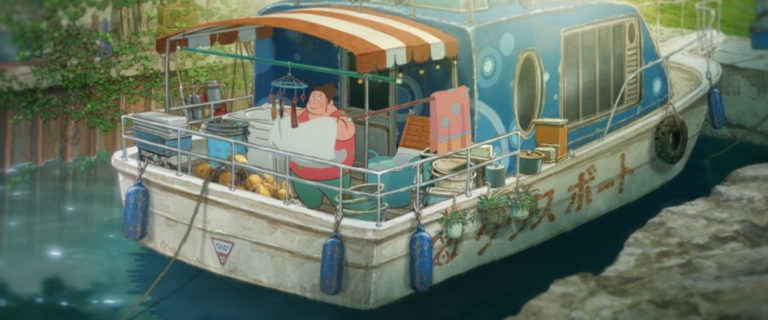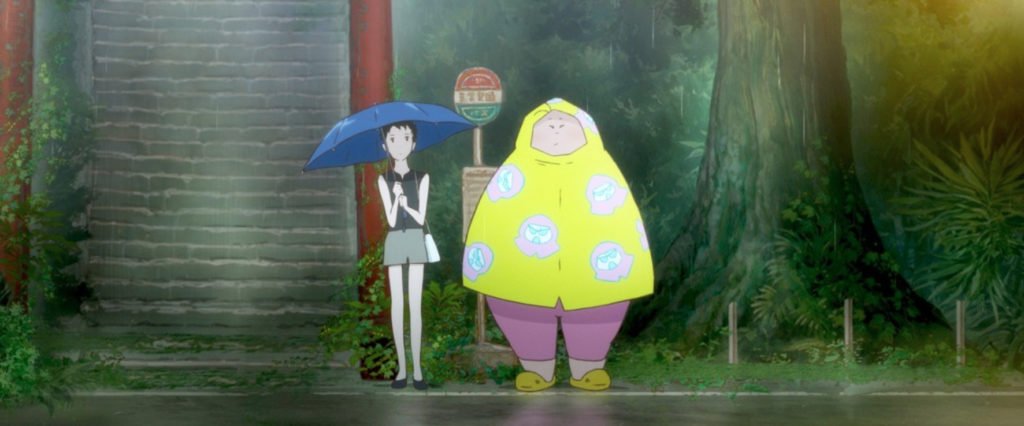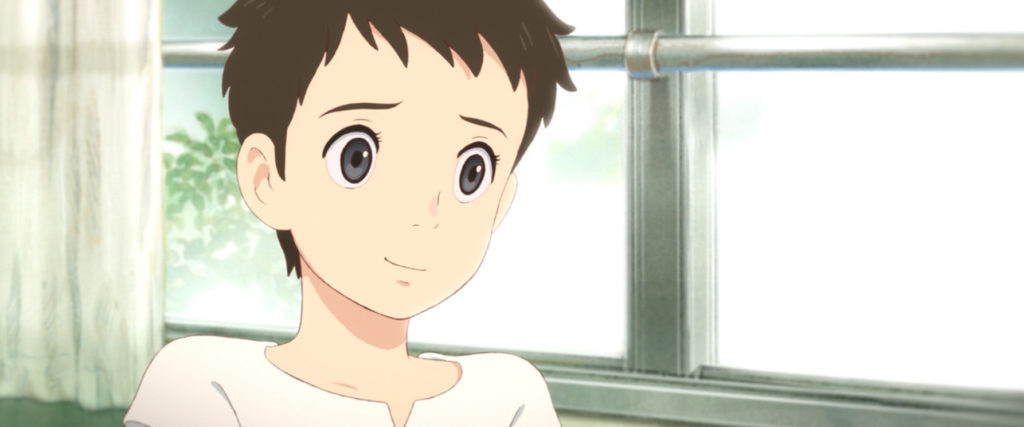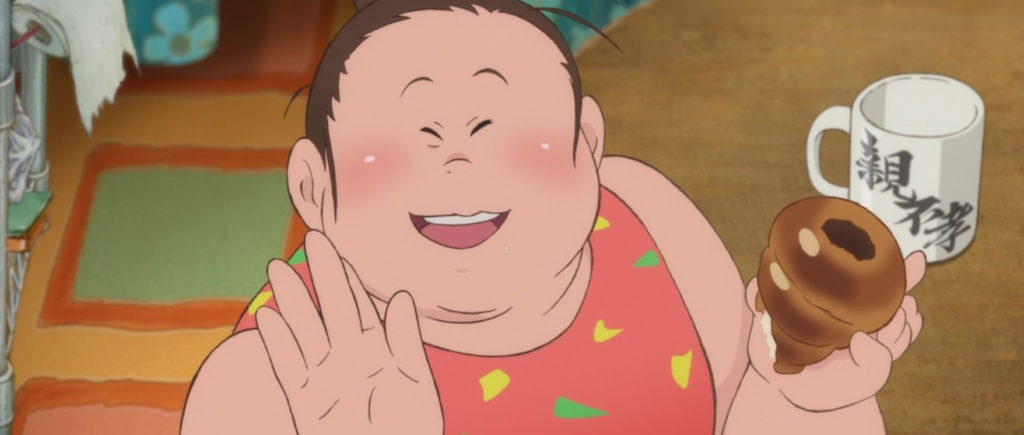
Synopsis : Brash single mother Nikuko is well-known for her bold spirit, much to the embarrassment of Kikuko, her pensive yet imaginative daughter. In contrast to her mother, Kikuko wants nothing more than to fit in as she navigates the everyday social dramas of middle school. Life in the harbor is peaceful until a shocking revelation from the past threatens to uproot the pair’s tender relationship.

Interview with Director Ayumu Watanabe
Q: What was the inspiration for a film that has all these situations involving motherhood such as becoming a “lady,” abandonment and responsibility?
AW: I think the biggest thing to the theme of my movie is that it’s about happiness. It looks like it’s really simple to find happiness.
The most important thing is if you can figure out how simple it is to find happiness.
Q: In your last movie, “Children of the Sea”, it was more ambiguous. “Nikuko-chan” is more funny and uplifting. Because Sanma Akashiya-san, the comedian, is the script writer for the movie, was the tone shaped because of him? How did you work with Akashia-san to make “Nikuko-chan” more lighthearted and uplifting?
AW: Yes, I agree that my last film, “Children of the Sea,” had a simple theme. But I depicted that theme in a difficult way. I’ll acknowledge that.
With regard to working with Sanma-san, he’s the kind of person who, at any time, anywhere, wants to make people laugh. That’s part of his personality and shows up here and there in the film. Even with people who don’t like him, he tries to make them laugh. That’s the kind of person he is.
Q: You were in the director’s chair for one of my favorite anime in recent memory, “After the Rain,” which focuses on two characters trying to rediscover their purpose in life. In a way, “Fortune Favors Lady Nikuko” has a similar concept, but it’s on a more spiritual level than simply about finding a goal in life. What makes you want to create anime or films with characters who have this kind of focus and mentality?
AW: It’s not like I choose what to work on. They sort of fall into my lap. But what I do like about what I show in movies is when the characters find a new purpose to life or when they have a new door open for them. when that happens, I really enjoy the emotional aspect of that moment. Thankfully, those kind of stories seem to come to me.
Q: Could you share some insights you got from Kanako Nishi’s original book? It was five or six years ago, but how did this book get turned into an animated film instead of live action movie? What was the creative involvement of Sanma-san? Was it as a storyboard, on in a screenplay?
AW: First of all, it was Sanma-san who read the novel and then he really decided to make it into a film. I think at first Sanma-san wanted to make it into a live action [production]. But the first problem we encountered was that it was really hard to find an actress who could depict Nikuko. If a human actress depicted Nikko’s characteristics, the specifics would be too harsh for the actor and wouldn’t bring out Nikuko’s character. So he thought, “Okay, maybe I could just do this in anime.” And that’s how making it in animation came about.
As to how involved Sanma-san was… He was there from developing the script, checking the script, and reviewing the storyboard. Especially with the recording, he was there most of the time, and, even during recording, he would suddenly come up with these jokes as an ad lib and incorporated them. This film really has a lot of the essence of Sanma-san in it.

Q: Despite being a well-rounded, down-to-earth tale, you mentioned that “Fortune Favors Lady Nikuko” is in some ways a fantasy. Can you elaborate on the animation process and how the film injects a magic to ordinary moments in life?
AW: When we talked about the existence of Nikuko, I wanted the audience to think, “Oh, did she really exist? Perhaps she doesn’t but I really want her to.” In order to make a character like that, I incorporated a lot of fantastical elements into her. She expresses a lot of cartoonish reactions, for example.
I tried to make the movie more relatable. I don’t know if any of the audience realized this, but I have one scene that has her [pay] homage or respect to certain anime films. So incorporating that was also part of the process.
Also, with the design style of Nikuko… I know she’s a little cartoonish and doesn’t match the rest of the characters in the film in terms of design, but I thought perhaps they could coexist in this movie.
What’s great about anime is that I’m allowed to do that. Accomplishing his challenge that I brought to the medium of anime was really fun. That’s what I wanted to do — challenge myself. I hope the audience will be a bit forgiving about that, but also enjoy it at the same time.
Q: There’s a scene that is very similar to a famous film, “My Neighbor Totoro,”which is wonderful and I love that you have used it. But why is the Sexy Temple called the “Sexy Temple?”
AW: The Sexy Temple was in the novel. Basically, the kids in the region would make out at that temple and which was the norm for what kids do “under the bleachers” — that type of thing. It was really clear in the novel why it’s called Sexy Temple, but I really didn’t think it was necessary to explain it in the film.
Q: I want to focus on the food in the movie. There’s quite a lot of it, and it’s in parallel to the people. For example, when they eat with the Misuji, they’re happy, all of them eating together. When Kikuko and Nikuko eat French toast or the meat sauce together, they’re happy that they’re together. So how did you work with art director Shinji Kimura to make the food pop out alongside the human relationships we share when we eat together?
AW: That’s a good question. In the end, for humans, it’s really easy to form a relationship when they’re eating together — especially with Nikuko who loves to eat. She’s the most happy when she’s eating. She spends a lot of time devoted to food, to eating, and to making food. When we first came up with the idea of doing this film, making and eating food was a big part of it.
In terms of relationships, Nikuko really takes the care and time to bring up Kikuko, which is really similar to how she follows a recipe. For example, with the French toast, it really goes back to her roots: the French toast is connected to Kikuko’s real mother. So there’s that connection with food and recipes and how tastes are brought along a generation. That was really important in showing the [relationship] in this film. So thank you. You are really understand the essence of the film.
Q: At first Nikuko is seen as a comedic and cartoonish character, but as we spend more time with her, we see her sympathetically and very relatable. How did you balance Nikuko’s sillier side with her more heartfelt elements to make her this very human character?
AW: It really goes back to how the design of Nikuko was developed. How much did she want to make her realistic, — where she wanted to be realistic was really the point. I discussed it with the character designer Konishi-san [Ken’ichi Konishi] extensively. We wanted to make her cartoonish, but also s with her movements.
I think this changes in the first half of the animation where she’s a bit more cartoonish, but then in the latter half she makes these small movements which are less cartoonish and more realistic. In the end, she does go back to being cartoonish a bit. But in the film as a whole, there’s a balance between the two and it shows the character as very relatable and human.

Q: There was a television show called “Baskets” [2016-2019] that aired over here and it had American comedian Louie Anderson playing the mother of Christine Baskets. At first she was seen as pretty funny, but as the show progressed, she became more than that, much more human and sympathetic. This portrayal came to mind when watching “Fortune Favors Lady Nikuko.”
AW: That’s great, I would love to see it.
Q: Please talk about the casting of Cocomi, the actress who plays Kikuko? I believe this is her cinematic debut; yet her performance is quite convincing. What preparation do you do with her?
AW: It really comes back to producer Sanma. He’s very good friends with her dad, who’s also in the industry [actor Takuya Kimura]. Sanma knew Cocomi as a kid, and he remembered that, as a kid, she used to say, “I have a dream of becoming a voice actress.” Sanma remembered that and thought, “Now I’m working on an anime, I would love to give her a part.”
At first he wasn’t thinking of giving her a main part; just a side character would have been fine. Because it was her first time acting, we didn’t even know if she could do it or how her voice was going to be. So we tested out the two young females, Kikuko and her friend Maria.
When we tested out Cocomi’s voice for Kikuko, her voice was so natural. It had that girlish element to it, a little unbalanced, not completely like an adult. Her voice fit Kikuko’s character perfectly It was so good that we asked her, “Could you please be our Kikuko?”
Q: Ninomiya is an elusive character, but he’s willing to share his deepest secrets with Kikuko. Was there a message about privacy sharing and the power of perspective that you meant to convey when he showed Kikuko his secret location and miniature model?
AW: Ninomiya is a really important character. He doesn’t really think about Kikuko deeply, but they feel this natural, mysterious connection to each other. They feel like they’re a little bit alike in the way they both think life is hard, or that it’s hard to fit in. So when they talk to each other, they realize that it’s easy to talk to so, and their sharing of what they feel or what they are like comes out naturally. I really wanted to show that.
With Kikuko and Ninomiya, it’s really not romantic. It’s the feeling that comes before a romantic feeling, something that attracts them to each other as humans. I wanted to show, “What does it takes for humans to be drawn to each other when they’re not family?” That comes through friendship and especially a friendship with someone of a different gender. It’s how Kikuko will eventually relate to society, and I think Ninomiya really helped as to how Kikuko will [do that]. Ninomiya was really important in that sense.
Q: How long did the production take for this film, and what challenges did you experience along the way? For example, with the pandemic, or the lockdown in Japan, in limiting people to have to work remotely and not go into the office for voice acting and production?
AW: Actually, the pandemic didn’t really affect this production much. That’s because Studio 4C is not that big, and there wasn’t enough people to put restrictions on. So in that sense we were lucky.
As to how long the production was, this happens with any anime, but we never had enough time. In our last film, “Children of the Sea”, it was a film we could have worked on forever. We could have added more touches here and there. In fact, it took six years to finish.
Because the last film took six years, for this film we were like, the first thing we have to do is finish this. In the two-and-a-half years that it took, it felt tight and we were always a little tense because we had to finish and meet the deadline.

Q: You’ve worked on movies and shows such as “Doraemon” and “Space Brothers” [“Uchuu Kyoudai”]. You have experience in reaching children and parents. In “Nikuko-chan” — even in the novel — it’s sometimes unsure of what kind of novel you’re reading. Is it fantasy? Is it realism? That’s the case here as well. We’ve seen the lizards and the talking animals. But then we have contrast of Sassan’s dead wife’s picture, or even harsh reality of Nikuko having to work to raise Kikuko. As a director, how did you balance out the elements of fantasy and reality so that children could understand it?
AW: I think the foundation of my work is really “Doraemon.” In “Doraemon,” it’s important to make sure that the story and everything is easy to understand for anyone and everyone. I really learned what’s important from “Doraemon.”
Since making into a film what started out as a novel, what’s so great about it is that it’s something you can share visually with others. That’s what I really strive to do, create a film that everyone could enjoy in the same space, and I will continue to do that
Q: One of the visual highlights of the film is the funny faces that Kikuko and Ninomiya make with each other. What was the inspiration for the funny faces that these two characters make?
AW: The funny faces were really hard for me because I was wavering as to whether to put them in or not. At first I was worried because it would be easy to notice this as an animation — and would it be funny? Or would it mess up the characters in regard to the story?
But we really wanted to be free from doing what’s normal. This film is about what’s normal that’s good, but the challenge was making it not normal. So we really went all out and made the funny faces funny. That’s really the great part about the freedom of what we can do with anime. If the audience can be more easy on us about how we “crush” those faces, that’s be great.
Also, if the audiences watching this movie ever want to make a funny face, this says,”don’t hold back. Just go ahead, go all out, and make your funniest face.” I would like everyone to be making funny faces.
I really think in the U.S. journalists really understood the essence of what I want to depict in this film. I really appreciate that, and thank you very much.
Check out more of Nobuhiro’s articles.
Here’s the trailer of the film.

